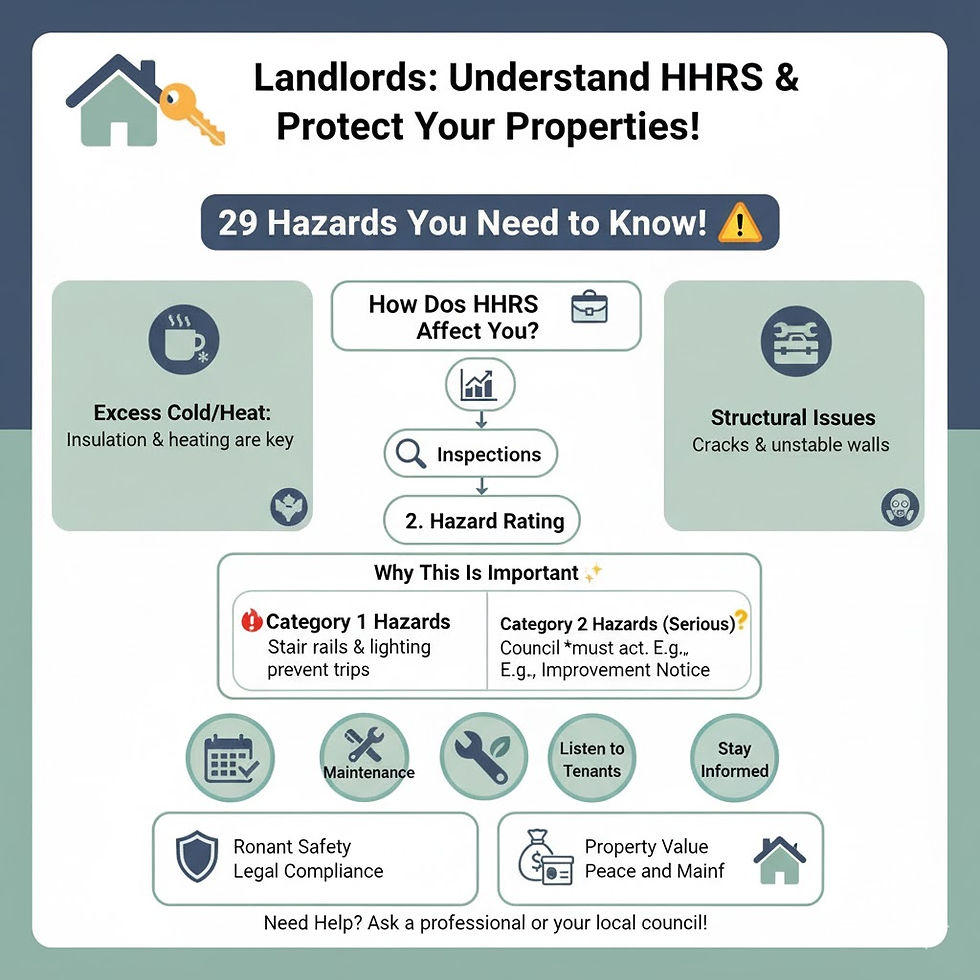Housing Health And Safety Rating System (HHSRS)
- lisaphilp2
- Oct 11
- 3 min read

Is Your UK Rental Truly Safe? The Landlord's Essential Guide to the HHSRS (Housing Health and Safety Rating System)
(H2) Introduction: Why HHSRS is Non-Negotiable for UK Landlords
As a UK landlord, your responsibilities extend far beyond collecting rent. Under the Housing Health and Safety Rating System (HHSRS), you have a legal duty to ensure your residential properties are safe, healthy, and hazard-free for your tenants.
Ignoring these guidelines can lead to heavy fines, legal enforcement, and, most importantly, serious risks to occupant well-being. This guide breaks down the HHSRS into simple, actionable steps to ensure your property portfolio remains compliant and profitable.
(H2) HHSRS Explained: The Risk-Based Approach
The HHSRS is a risk assessment framework used by local authorities (councils) to evaluate potential hazards within a dwelling. Unlike old systems that looked at minimum standards, HHSRS focuses on the risk posed by any deficiency to the health and safety of the most vulnerable potential occupant.
It answers two key questions:
What is the likelihood of a hazard occurring within the next 12 months?
What is the potential severity of harm that could result?
The final score determines whether the hazard is a Category 1 (Serious) or Category 2 (Less Serious) risk.
(H3) The 29 Hazards You Must Know
The system assesses 29 specific hazards, grouped into four main areas. A Category 1 finding on any of these requires the local authority to take enforcement action.
Hazard Category | Examples of Hazards | Landlord Action Focus |
Physiological | Damp & Mould Growth, Excess Cold/Heat, Asbestos, Carbon Monoxide | Insulation, ventilation, adequate heating, boiler/gas safety checks. |
Psychological | Crowding & Space, Lighting, Noise, Entry by Intruders (Security) | Proper security (locks, lighting), adequate room sizes, noise reduction. |
Protection Against Infection | Domestic Hygiene, Food Safety, Personal Hygiene & Sanitation, Water Supply | Cleanliness, proper drainage, hot/cold water supply, non-contaminated water. |
Protection Against Accidents | Falls on Stairs/Levels, Fire, Electrical Hazards, Structural Collapse | Stair rails, adequate lighting, working smoke/CO alarms, EICR certification, structural maintenance. |

(H2) The Enforcement Process: What Happens If You're Non-Compliant
The HHSRS process empowers local councils to investigate properties and demand improvements.
The Process in Action:
Inspection: A council Environmental Health Officer (EHO) conducts a detailed inspection, often prompted by a tenant complaint.
Assessment: The EHO scores each hazard using the HHSRS matrix.
Category 1 (Serious Hazard): If a serious risk is found, the council must act. This often results in a formal notice:
Improvement Notice: Requires you to complete specified remedial works within a set timeframe.
Prohibition Order: Bans the use of all or part of the dwelling until the hazard is removed.
Category 2 (Less Serious Hazard): The council has the power to act but may opt for a Hazard Awareness Notice or informal action.
Penalties: Failure to comply with an Improvement or Prohibition Notice is a criminal offence and can lead to prosecution or a Civil Penalty Fine of up to £30,000.

(H2) Your Proactive Compliance Checklist
Don't wait for the council to call. Proactive maintenance is the best legal and financial strategy.
Key Actions for Landlords:
Conduct Regular Audits: Perform a thorough, documented inspection of your property at least annually. Use the 29 hazards as your checklist.
Maintain Records: Keep detailed records of all maintenance, repairs, gas safety certificates (GSCC), and electrical safety certificates (EICR). This is your key defence in any dispute.
Act Fast on Damp and Mould: Treat the root cause of damp (e.g., failed guttering, poor ventilation, insufficient insulation), not just the visible mould.
Ensure Fire Safety: Install and regularly test smoke alarms on every floor and CO alarms in any room with a fuel-burning appliance.
Educate Tenants: Provide clear information on how to use ventilation and heating systems correctly to minimise condensation risks.
(H2) Conclusion: Protect Your Investment, Prioritise Your Tenants
HHSRS is an essential tool for creating a safer, higher-quality private rental sector. By adopting a proactive and preventative maintenance strategy, you not only protect your tenants from harm but also protect your business from costly enforcement action and significant financial penalties.
Need help assessing your portfolio? Consult a professional property management service or a specialist HHSRS assessor for a comprehensive review.
#LandlordLife #UKProperty #HHSRS #PropertyManagement #TenantSafety #RentalProperty #UKLandlords #HousingStandards #Inventory clerk #inventory clerk cambridge #cambridge inventory clerk #cambridge lettings #cambridge property #cambridge inventory services
.png)

.png)
.png)






Comments